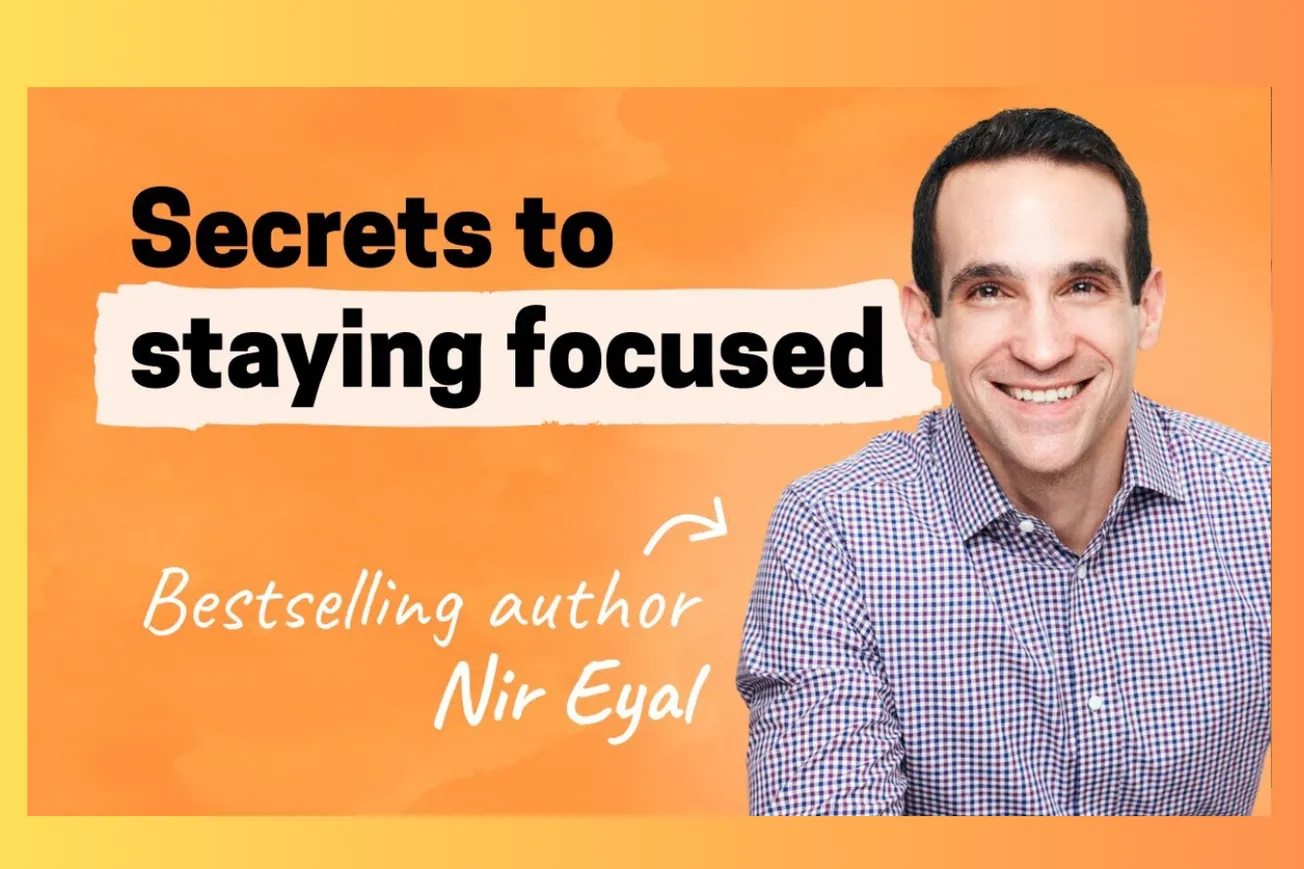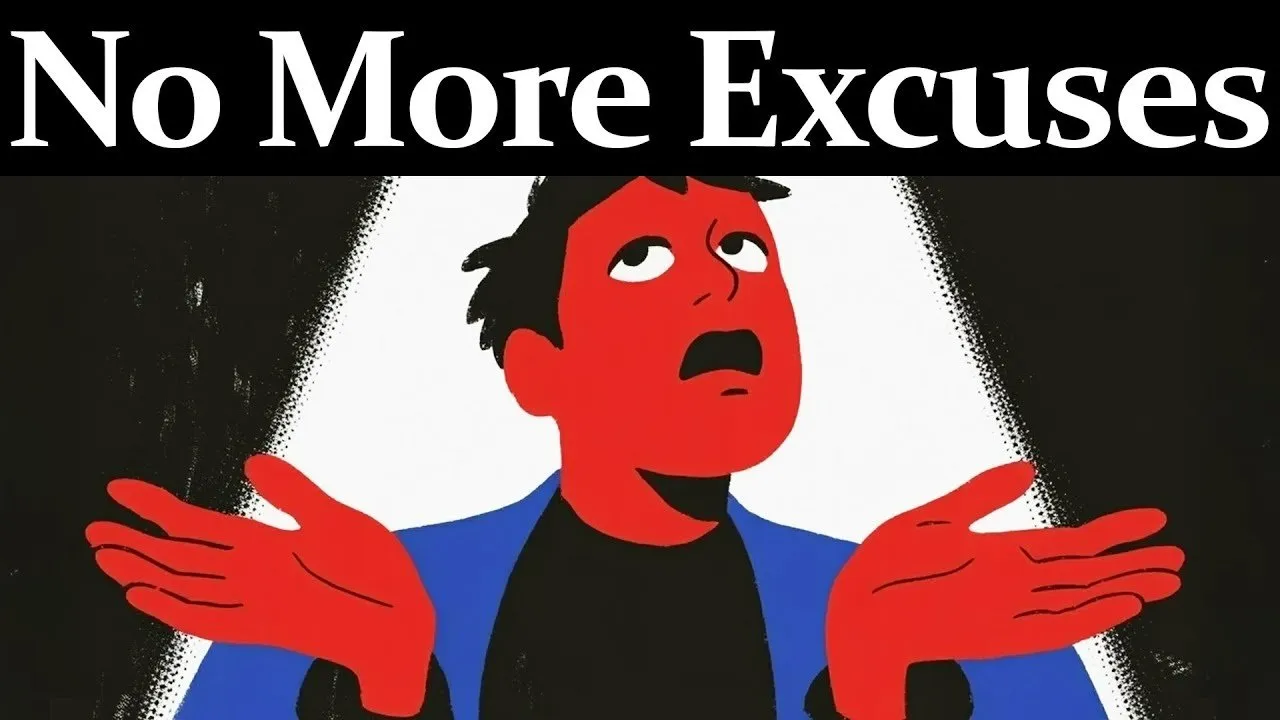Table of Contents
Learn the four-step system that helped the "Hooked" author overcome his own distraction problems and achieve peak productivity.
Key Takeaways
- Distraction is fundamentally an emotion regulation problem, not a technology problem
- 90% of distractions come from internal triggers (boredom, anxiety, fatigue) rather than external notifications
- The opposite of distraction is "traction" - any action that pulls you toward your intended goals
- The four-step framework: master internal triggers, make time for traction, hack back external triggers, prevent distraction with pacts
- The 10-minute rule helps surf emotional urges without giving in to distraction
- Time-boxing your calendar based on values is more effective than traditional to-do lists
- Pacts create pre-commitments that serve as a firewall against distraction
- High performers feel the same discomfort as everyone else but use it as rocket fuel toward their goals
- Companies need psychological safety, forums for discussion, and management modeling to create indistractable workplaces
Timeline Overview
- 00:00–04:20 — Nir's Background and Book Origins: How writing about distraction for five years led to discovering myths about productivity and developing a research-based framework for focus
- 04:20–07:43 — How to Become Less Distractible: The foundational insight that conventional solutions (stop using technology) don't work for working professionals who need these tools
- 07:43–12:52 — Understanding Distraction and Traction: The crucial distinction that separates actions based on intent - traction pulls you toward goals, distraction pulls you away
- 12:52–13:53 — The Four Steps to Becoming Indistractable: Overview of the complete framework that addresses both internal and external triggers systematically
- 13:53–18:49 — Mastering Internal Triggers: Why 90% of distraction starts from within and how to identify the emotional discomfort driving procrastination
- 18:49–23:20 — Surfing the Urge with a 10-Minute Timer: The practical technique for postponing distraction while acknowledging that emotions are temporary like waves
- 23:20–25:02 — Making Time for Traction with a Timebox Schedule: Why you can't call something a distraction unless you know what it distracted you from
- 25:02–28:36 — How to Turn Your Values into Time: The weekly planning process that aligns calendar blocks with personal values across three life domains
- 28:36–29:22 — Booking Deep Work Time: Real-world examples of protecting focus time and the importance of constraints over endless to-do lists
- 29:22–31:00 — Making Pacts to Prevent Distraction: Using pre-commitments and the psychology of identity to create barriers against distraction
- 31:00–34:31 — The Problem with To-Do Lists: Why checking boxes creates false productivity and the planning fallacy that makes everything take three times longer
- 34:31–36:08 — The Drawback of Deadlines: How last-minute pressure produces poor quality work and the importance of consistent progress over cramming
- 36:08–39:54 — Distraction is an Emotion Regulation Problem: The neurological truth that all human motivation stems from escaping discomfort, not pursuing pleasure
- 39:54–45:03 — Hacking Back External Triggers: Practical tools for managing notifications, family interruptions, and workplace distractions systematically
- 45:03–48:18 — Preventing Distraction with Pacts: Three types of pacts (price, identity, effort) that create barriers and pre-commitments against distraction
- 48:18–53:42 — Specific Tools to Hold You Accountable: Forest app, Focus Mate, outlet timers, and other technologies that insert friction and mindfulness
- 53:42–56:37 — Managing Emotions and Discomfort: Additional techniques for reimagining tasks, triggers, and temperament to handle internal resistance
- 56:37–01:00:09 — Taking Responsibility and Being High-Agency: The empowering shift from victim mindset to personal responsibility and the social antibodies concept
- 01:00:09–01:05:04 — Becoming Indistractable at Work: Three traits of indistractable companies: psychological safety, forums for discussion, and management modeling
- 01:05:04–01:09:36 — Schedule Syncing to Align with Managers: The practical process for managing up by showing calendar priorities and asking for help with prioritization
- 01:09:36–01:16:00 — We Are Not as Hooked on Technology as People Think: The contrarian view that most technology use is distraction, not addiction, and why personal responsibility matters
- 01:16:00–01:17:38 — Life Purpose and Personal Responsibility: The importance of forethought over impulsiveness and developing skills for impulse control
- 01:17:38–end — Lightning Round: Book recommendations, favorite products, life mottos, and the difference between habits and routines
The Foundational Insight: Distraction Is Not a Technology Problem
Nir Eyal's journey to understanding distraction began with his own struggles. Despite buying a 1990s flip phone from China and a vintage word processor from eBay to eliminate digital distractions, he still found himself procrastinating. "Even when I stopped using all the technology, even when I got rid of all the apps, I would sit down at my desk and I'd say oh you know what, there's that book that I've been meaning to do some research in or let me just clean off my desk real quick."
This revelation led to his core insight: "The problem is not our technology. The problem is our inability to deal with discomfort." Research supports this counterintuitive finding - studies show that only 10% of distractions come from external triggers like notifications. The remaining 90% originate from internal triggers: boredom, loneliness, fatigue, uncertainty, and anxiety.
This distinction is crucial because it shifts focus from external solutions (blocking apps, turning off notifications) to internal skills (emotional regulation, discomfort tolerance). While external tools can help, they're addressing symptoms rather than the root cause. The real work happens in developing the ability to sit with discomfort and use it productively rather than escaping from it.
Nir's framework recognizes that high performers in every field - business, arts, sports - feel the same internal triggers as everyone else. The difference is that high performers "use that discomfort like rocket fuel to propel them towards traction, whereas distractable people, as soon as they feel uncomfortable, as soon as they feel bored, as soon as they feel lonesome, as soon as they feel indecisive or stressed, boom they're escaping it."
Traction vs. Distraction: The Intent-Based Framework
The foundation of Nir's system rests on understanding what distraction actually means. Most people incorrectly assume the opposite of distraction is focus, but Nir reveals a more precise definition: "The opposite of distraction is not focus. The opposite of distraction is traction."
Both words share the same Latin root "trahere" (to pull) and end with "action," emphasizing that distraction isn't something that happens to us - it's an action we take. This reframe is psychologically powerful because it restores agency to the individual.
Traction = Any action that pulls you toward what you say you were going to do, things done with intent that move you closer to your values and help you become the person you want to become.
Distraction = Any action that pulls you away from what you planned to do, moving you further from your goals and away from becoming the person you want to become.
The critical differentiator is intent. As Dorothy Parker observed, "The time you plan to waste is not waste of time." This means checking social media can be traction if it's scheduled and intentional, while checking work email can be distraction if it's avoiding the important project you planned to work on.
This framework eliminates moral judgment about activities. Watching Netflix, playing games, or browsing social media aren't inherently good or bad. The question is whether these activities align with your intentions and values or serve as escape mechanisms from discomfort.
The Four-Step Indistractable Framework
Nir's systematic approach addresses distraction through four sequential steps, each building on the previous one:
Step 1: Master Internal Triggers - The most crucial step involving techniques for managing the emotional discomfort that drives 90% of distractions.
Step 2: Make Time for Traction - Converting values into time through calendar-based planning rather than relying on to-do lists.
Step 3: Hack Back External Triggers - Systematically reducing unauthorized access to your attention from notifications, interruptions, and environmental factors.
Step 4: Prevent Distraction with Pacts - Creating pre-commitments that serve as a firewall against distraction when other steps aren't sufficient.
The sequential nature matters because attempting Step 4 (pacts) without mastering Steps 1-3 typically fails. Each step provides essential skills and systems that support the others.
Step 1: Mastering Internal Triggers Through the 10-Minute Rule
The most powerful technique in Nir's arsenal is the 10-minute rule, which he uses "almost every single day." When feeling the urge to check email, social media, or engage in any avoidance behavior, he sets a timer for 10 minutes with two options:
- Return to the intended task
- Surf the urge - experiencing the discomfort without acting on it
The key insight is that emotions are temporary, like waves that "crest and then subside." Most people think about emotions as permanent states - "if I feel bored, I feel like I'm always going to be bored" - but this isn't true. The 10-minute rule acknowledges this temporal nature while building tolerance for discomfort.
During these 10 minutes, Nir repeats his personal mantra: "This is what it feels like to get better." This reframe transforms discomfort from something to escape into evidence of growth and improvement. The mantra can be personalized, but the principle remains: acknowledging difficulty as part of progress rather than a problem to solve.
The technique isn't about permanent abstinence (which often backfires psychologically) but postponement. "You're not saying no, you're saying not yet." This approach reduces psychological reactance while building confidence in one's ability to delay gratification.
Nine times out of ten, by the end of the 10 minutes, the urge has passed and focus returns naturally to the intended task. Over time, the 10-minute rule can extend to 12 minutes, 20 minutes, or longer, gradually building distraction resistance.
Step 2: Making Time for Traction Through Value-Based Scheduling
Nir's approach to planning fundamentally challenges conventional productivity wisdom. Instead of starting with tasks (to-do lists), he starts with values and converts them into time allocations. "You cannot call something a distraction unless you know what it distracted you from."
The weekly planning process takes about 10 minutes every Sunday evening and involves examining three life domains:
You Domain (Self-Care): How does the person you want to become take care of themselves? This includes sleep (Nir has a scheduled bedtime after his daughter pointed out his hypocrisy), exercise, reading, meditation, or any personal activities aligned with your values.
Relationships Domain: Intentional time for significant others, children, friends, and family. "Don't let the relationships in your life get whatever scraps of time are left over." This prevents the loneliness epidemic by ensuring friendships don't "starve to death" from neglect.
Work Domain: Two types of work require different approaches:
- Reactive Work: Responding to emails, notifications, and colleague requests
- Reflective Work: Planning, strategizing, thinking, and focused project work
The calendar-based approach forces trade-offs that to-do lists avoid. "What you're going to find is that there's never enough time for everything, which is good because what this forces you to do... is understand that there are trade-offs that you have to prioritize properly."
This constraint-based planning eliminates the psychological trap of endless to-do lists that create feelings of inadequacy. Instead of feeling like a "loser" for not completing everything, you measure success by whether you did what you planned for as long as you planned to do it.
Step 3: Hacking Back External Triggers
While external triggers cause only 10% of distractions, managing them strategically creates an environment that supports focus. Nir uses "hack" intentionally - these technologies are "gaining unauthorized access to our attention span when they're constantly pinging and dinging us."
Digital Environment:
- Desktop computers on "do not disturb" from midnight to 11:59 PM (essentially always)
- Scheduled focus time with automatic notification blocking
- Strategic app placement and notification settings
Family and Household Management: The "concentration crown" - a simple $10 LED-lit wreath from Amazon that signals unavailability. When worn during 30-minute maximum focus blocks, it tells family members (including spouses) that interruption isn't appropriate unless someone is "bleeding."
This visual cue works because it removes ambiguity. Family members know the person is doing focused work (not watching videos) and that availability will return within a specific timeframe.
Workplace Interruptions: Every copy of "Indistractable" includes a fold-out card that reads "I'm indistractable at the moment. Please come back later." This makes focused work culturally acceptable rather than antisocial.
The approach extends beyond obvious external triggers to include "what about stupid meetings that didn't need to be called, what about emails that didn't need to be sent and received, what about our kids." The goal is systematically reducing unauthorized access across all potential interruption sources.
Step 4: Preventing Distraction with Pacts
Pacts serve as the "firewall" against distraction when other steps aren't sufficient. Nir identifies three types of pre-commitments:
Price Pacts: Financial consequences for going off-track. Nir used this to get in shape (moving from clinically obese to his best physical condition at age 45) and to finish writing "Indistractable." The key is making the stakes high enough to motivate compliance without being so extreme they backfire.
Identity Pacts: Adopting personal identity labels that guide behavior. Just as "I'm a vegetarian" eliminates daily decisions about meat consumption, "I'm indistractable" becomes a personal standard. This borrows from the psychology of religion where identity drives consistent behavior.
Effort Pacts: Creating friction that requires conscious choice to engage in distracting behavior. Nir's personal example involves a $10 outlet timer that shuts off his internet router every night at 10 PM. While he could restart it, the effort required creates a moment of mindfulness: "Do I really need to go all that trouble... or should I do what I said I was going to do?"
The outlet timer solution improved his marriage by eliminating the pattern where both spouses would "be fondling" their devices instead of being intimate. The automatic shutdown created a shared boundary that supported their relationship values.
The Problem with To-Do Lists and Better Alternatives
Nir's critique of to-do lists reveals fundamental flaws in how most people approach productivity:
Lack of Constraints: "You can always add more to a to-do list" without considering time limitations or trade-offs.
No Feedback Loop: To-do lists don't help you understand how long tasks actually take, leading to the planning fallacy where "tasks take people three times longer to finish than they estimate."
False Productivity Metrics: Measuring success by checking boxes rather than by time invested creates a cycle where people prioritize easy, urgent tasks over important, difficult work.
Psychological Harm: Coming home to a 100-item to-do list reinforces "this self-image as someone who doesn't know how to manage their time."
The alternative approach measures success differently: "Did I do what I said I was going to do for as long as I said I would without distraction?" This metric provides feedback about personal productivity rates and builds confidence in one's ability to follow through on commitments.
When working on a 30-slide presentation for 30 minutes and completing 2 slides, you learn that you need 10 more time blocks to finish. This enables accurate planning and prevents last-minute cramming that produces poor-quality work under stress.
The Neuroscience of Motivation and Emotional Regulation
Nir's research reveals a counterintuitive truth about human motivation that contradicts common assumptions about carrots and sticks. "Neurologically speaking, it's not about the pursuit of pleasure and the avoidance of pain... the carrot is the stick."
All human action stems from the desire to escape discomfort. Even pursuing pleasurable sensations creates psychological tension - "wanting to feel good, craving, lusting, desire, hunger, that desire for something that feels good is itself psychologically destabilizing."
This insight is "incredibly empowering because what that means is that whenever we don't do something, whenever we procrastinate, it's just a feeling. It's all it is. It's just a feeling." Once you understand that procrastination is fundamentally an emotion regulation problem rather than a character flaw, you can develop specific skills to manage it.
The universality of this experience means "there's a 99% chance there's nothing wrong with you" if you struggle with distraction. It's simply that most people lack tools for managing emotional discomfort, leading them to seek escape through various behaviors.
This reframe from "broken" to "unskilled" opens possibilities for improvement through practice rather than treatment. Like any skill, distraction resistance can be developed through consistent application of specific techniques.
Creating Indistractable Workplaces
Nir's research identified three essential traits of companies that successfully support employee focus:
Psychological Safety: Teams must be able to discuss distraction as a business problem without fear of being labeled lazy or unproductive. "If you can't talk about a problem, if you can't raise your hand and say hey, you know what, I'm just not able to do my best work when I'm constantly expected to reply to every email, to every notification every 30 seconds... that is the problem."
Forums for Discussion: Dedicated channels or meetings for addressing distraction issues. Slack created "beef tweets" channels where employees could voice concerns, with management responding through emoji (green checkmark for fixed issues, eyes emoji for acknowledged but unfixable problems).
Management Modeling: Leadership must exemplify indistractable behavior because "culture is like water - it flows downhill." Slack's headquarters featured "Work Hard and Go Home" in bright pink letters, with actual consequences for after-hours communication.
The Boston Consulting Group transformed from one of the most distractable companies to being ranked among America's best workplaces by implementing "predictable time off" meetings and systematic culture change around these principles.
Schedule Syncing: Managing Up for Better Focus
One of Nir's most practical workplace strategies involves "schedule syncing" or "managing your manager." This process prevents the common problem where individual focus efforts are undermined by constantly changing priorities from leadership.
The process requires creating a time-boxed calendar and then requesting a brief weekly meeting with your manager. Present both your calendar and a separate list of additional requests that don't fit within your time blocks. "You're not saying no, you're saying here's my calendar, here's this list of stuff you've asked me to do. Help me prioritize."
This approach succeeds because prioritization is fundamentally a manager's job, not an individual contributor's responsibility. Most managers appreciate the visibility into how their reports spend time and can make informed trade-offs between competing priorities.
The technique works equally well in personal relationships. Nir and his wife do weekly five-minute schedule syncs that prevent conflicts about household responsibilities and childcare logistics. "We prevent so many conflicts just by doing this simple schedule sync process."
The Contrarian View on Technology Addiction
Nir challenges the prevalent narrative that technology is inherently addictive or harmful, arguing that most technology use represents distraction rather than true addiction. Clinical addiction requires "persistent compulsive dependency on a behavior or substance that harms the user" and affects only 3-5% of the population.
The overuse of "addiction" terminology serves psychological purposes: "It's much easier to tell ourselves I'm enslaved, my brain is being hijacked, my focus is being stolen, it's all Silicon Valley's fault, as opposed to saying wait a minute... now I have personal responsibility."
For the vast majority of users, technology provides an escape from emotional discomfort rather than creating genuine dependency. This distinction matters because addiction requires clinical intervention, while distraction can be managed through skill development and environmental design.
Nir advocates for special protections for children and genuinely addicted individuals while maintaining that most adults can take personal responsibility for their technology use. This nuanced view acknowledges real problems while avoiding the learned helplessness that comes from believing technology companies control our behavior.
Conclusion
Nir Eyal's framework for becoming indistractable represents a fundamental shift from external solutions to internal skill development. By recognizing that distraction is primarily an emotional regulation problem, his approach empowers individuals to take control of their attention through systematic, evidence-based methods.
The four-step system - mastering internal triggers, making time for traction, hacking back external triggers, and preventing distraction with pacts - provides a comprehensive toolkit for anyone struggling with focus and productivity. More importantly, it reframes distraction from a character flaw or external imposition to a learnable skill set.
As Nir emphasizes, "The antidote for impulsiveness is forethought." By planning ahead and developing specific techniques for managing discomfort, anyone can become indistractable. The key insight is that high performers feel the same emotional triggers as everyone else - they simply have better tools for using that discomfort productively rather than escaping from it.
Practical Implications
- Implement the 10-minute rule immediately - Next time you feel the urge to check social media or email during focused work, set a timer and either return to your task or surf the urge until it passes
- Abandon to-do lists in favor of time-boxed calendars - Spend 10 minutes each Sunday planning your week by allocating time blocks for self-care, relationships, and different types of work
- Identify your internal triggers - Notice what emotions (boredom, anxiety, frustration) precede your distraction episodes and develop specific mantras or techniques for each trigger
- Create effort pacts for recurring problems - Use simple tools like outlet timers, website blockers, or apps like Forest to insert friction between impulse and action
- Practice schedule syncing with your manager - Show your time-boxed calendar and ask for help prioritizing conflicting demands rather than trying to do everything
- Implement family focus signals - Use visual cues like the concentration crown or "do not disturb" signs to communicate when you're doing focused work
- Measure success by intention, not completion - Track whether you did what you planned for as long as you planned, regardless of how much you finished
- Adopt an indistractable identity - Start describing yourself as someone who works without constant interruption, making it part of your personal brand and standards
- Address workplace distraction systematically - If you're a leader, create psychological safety for discussing focus challenges and model indistractable behavior consistently





